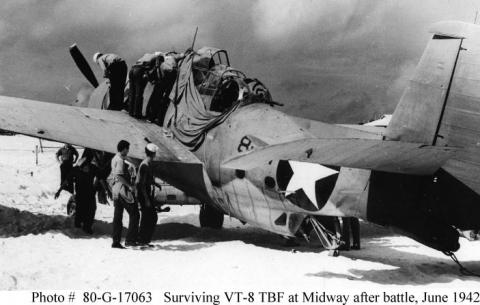EARNEST-ALBERT
ALBERT KYLE "BERT" EARNEST

CAPT

AWARDED NAVY CROSS THREE TIMES
Albert Kyle Earnest graduated from Virginia Military Institute in 1938 with a Bachelor of Science degree in Civil Engineering and was commissioned a Second Lieutenant, Field Artillery, U.S. Army Reserve. In February 1941 he resigned from the Army and joined the Navy to become a Naval Aviator. His first fleet assignment was with Torpedo Bomber Squadron 8 (VT-8) and he was one of six pilots who flew the new torpedo bomber TBF-1 Avergers to Midway Island three days before the Battle of Midway began. When the battle began, then Ensign Earnest flew the TBF-1 in its first combat use in the Battle of Midway and was the only land based pilot to survive the battle. For his actions during the battle he was twice awarded the Navy Cross. During later action in the area of Guadalcanal in September-October 1942 he was awarded his third Navy Cross. During his 31-years in the Navy he had an illustrious career. He died on October 27, 2009, and has been interred at Arlington National Cemetery.
NAVY CROSS CITATION #1: The President of the United States of America takes pleasure in presenting the Navy Cross to Ensign Albert Kyle Earnest, United States Naval Reserve, for extraordinary heroism in operations against the enemy while serving as Pilot of a carrier-based Navy Torpedo Plane of Torpedo Squadron EIGHT (VT-8), embarked from Naval Air Station Midway during the "Air Battle of Midway," against enemy Japanese forces on 4 June 1942. In the first attack against an enemy carrier of the Japanese invasion fleet, Ensign Earnest pressed home his attack in the face of withering fire from enemy Japanese fighters and anti-aircraft forces. His outstanding courage and determined skill were at all times inspiring and in keeping with the highest traditions of the United States Naval Service.
NAVY CROSS CITATION #2: The President of the United States of America takes pleasure in presenting a Gold Star in lieu of a Second Award of the Navy Cross to Ensign Albert Kyle Earnest, United States Naval Reserve, for extraordinary heroism in operations against the enemy while serving as Pilot of a carrier-based Navy Torpedo Plane of Torpedo Squadron EIGHT (VT-8), embarked from Naval Air Station Midway during the "Air Battle of Midway," against enemy Japanese forces on 4 June 1942. Having completed an unsupported torpedo attack in the face of tremendous enemy fighter and anti-aircraft opposition, Ensign Earnest, himself wounded and his gunner dead, made his return flight in a plane riddled by machine gun bullets and cannon shell. With his compass and Bombay doors inoperative, one wheel of his landing gear unable to be extended and his elevator-control shot away, he was forced to fly by expert use of his elevator trimming tabs some 200 miles back to Midway where he negotiated a safe one-wheel landing. Fully aware of the inestimable importance of determining the combat efficiency of a heretofore unproven plane, Ensign Earnest doggedly persisted in spite of tremendous hazards and physical difficulties. His great courage and marked skill in handling his crippled plane were in keeping with the highest traditions of the United States Naval Service.
NAVY CROSS CITATION #3: The President of the United States of America takes pleasure in presenting a Second Gold Star in lieu of a Third Award of the Navy Cross to Ensign Albert Kyle Earnest, United States Naval Reserve, for extraordinary heroism in operations against the enemy while serving as Pilot of a carrier-based Navy Torpedo Plane in Torpedo Squadron EIGHT (VT-8), attached to the USS. HORNET (CV-8), in action on 16 and 22 September 1942, and 9 to 12 October 1942, while deployed over the Solomon Islands. As part of a composite striking force which launched an attack against hostile surface units about 150 miles northwest of Guadalcanal, Lieutenant (junior grade), Earnest contributed to the scoring of a torpedo hit on a Japanese cruiser. On 22 September, together with two other torpedo bombers, he glide-bombed enemy installations at Cape Esperance. On 9 October, in a striking force operating 140 miles northwest of Guadalcanal, he obtained a direct hit which put a heavy cruiser out of action. On 10 and 12 October he participated in air raids against Japanese naval units which resulted in another hit on an enemy warship about 165 miles off Guadalcanal. His cool courage and conscientious devotion to duty, maintained at great risk in the face of grave danger, were in keeping with the highest traditions of the United States Naval Service.
Submitted by CDR Roy A. Mosteller, USNR (Ret)


